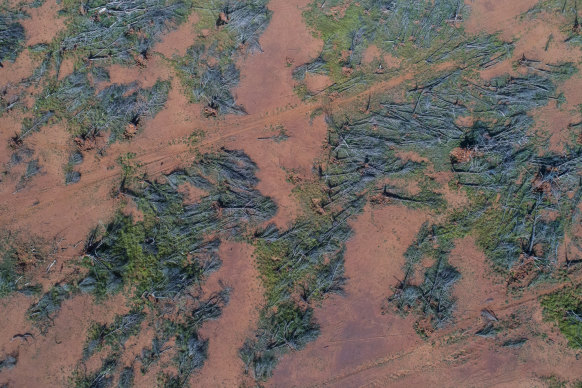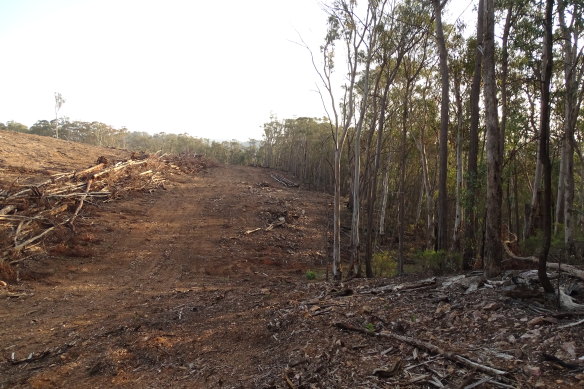‘Unpick the damage that’s been done’: Inside NSW plan to rein in rampant land-clearing
The NSW government will lay out its plan to unscramble the controversial biodiversity offsets scheme and rein in rampant land-clearing on private land, setting the scene for a political fight over the rights of landowners.
NSW Environment Minister Penny Sharpe said the response to be released on Wednesday “starts to unpick the damage ... done since 2016”, when the former government introduced the offsets scheme and loosened restrictions on land-clearing.
“Biodiversity loss is as important and critical as action on climate change, and reversing it is really important,” Sharpe said.

Farmers defended Australian agriculture’s environmental record but ecologists list land-clearing as a top cause of wildlife losses.Credit: Nick Moir
In a whole-of-government response that cuts across both Sharpe’s portfolio and that of Agriculture Minister Tara Moriarty, the government has accepted all findings and most recommendations of two reviews, one of the Biodiversity Conservation Act led by former Treasury secretary Ken Henry and an internal review of the Local Land Services Act.
Sharpe said the first wave of legislation would be introduced within months to strengthen the Biodiversity Offsets Scheme. This is a mechanism established by the former government in 2016 that allows developers to destroy biodiversity if they pay into a fund that invests in projects to enhance biodiversity elsewhere.
The Henry review found last August that the laws were failing to ensure biodiversity was conserved in NSW and recommended the state take a “nature-positive” approach by which biodiversity is improved rather than just maintained.
An investigation by The Guardian in 2021 found widespread problems with the offset scheme, including developers paying to protect land that was already protected. Henry said the Biodiversity Conservation Trust struggled to find enough good local offset projects to fund, and that risked the scheme becoming “a developer tax” rather than protecting biodiversity.
Sharpe said there were problems with the scheme but said there was still a need for offsets, especially given the commitment of the Minns government to tackle the housing crisis.
“We want genuine [avoidance] and mitigation before clearing, and we want to put biodiversity upfront so that it actually is considered at the beginning, not at the end,” Sharpe said.
“There’s always going to be a need to do some offsetting because we have to build some of those things, but we want a really a much stronger regime about how that operates.”
The government did not accept Henry’s recommendation that the Biodiversity Conservation Act should have primacy if different pieces of legislation contradicted each other. Instead, the government pledged to reform all the other relevant pieces of legislation to ensure consistency.

Land-clearing in NSW skyrocketed after the 2016 laws passed parliament.
Greens representative Sue Higginson said the response rolled back the “worst aspects of the war on nature that was waged by the Liberal National Coalition” but did not do what was necessary to reverse the trajectory of biodiversity loss across NSW.
“The only way that will happen is if the government does what Henry recommended – for biodiversity conservation laws and policies of nature repair to take primacy over planning, development and land use laws … it is clear from this response that the government is not willing to do that,” Higginson said. “It’s a very sad day for nature in NSW.”
Henry said the government’s intended approach might take longer but would achieve the same outcome as his recommendation.
“I certainly can’t criticise this as an approach because it’s intended to do precisely what we were focused on ourselves,” he said. “I feel pretty good about where they’ve landed, honestly. It’s a very serious response to a very serious set of issues.”
Henry said the government also did not go as far as the recommendation to publish detailed landscape plans that set aside “no-go areas for development”, but had endorsed the concept of detailed regional plans.
The government also plans to tighten the rules in the Local Land Services Act for clearing vegetation on private land. NSW government data shows land-clearing skyrocketed particularly in the agricultural sector after rules were loosened in 2016.
The proposals include reducing areas approved to be cleared and increasing areas protected in perpetuity, reinstating caps on land-clearing and incentivising landowners to improve native vegetation. Legislation could be introduced next year after public consultation.
The 2016 legislation was opposed by Labor at the time, but rather than repeal it, the government has opted for broader reform.
The land-clearing reforms were strongly backed by the Nationals and the National Farmers Federation at the time.
Sharpe said the government planned to take a “collaborative and inclusive” approach, both through public consultations and the parliamentary process.
“The government’s made no secret of our concern about excessive land-clearing,” Sharpe said. “I’m actually more optimistic that there is a chance to have a little bit more consensus than there has been in the past.”
Get to the heart of what’s happening with climate change and the environment. Sign up for our fortnightly Environment newsletter.